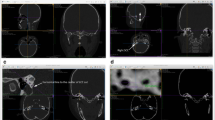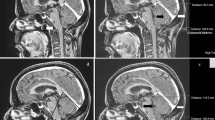Abstract
Introduction
The knowledge acquired on the lateral fossa of the brain (LFB) is heterogeneous and incomplete. Our goal was to provide a morphological description of the LFB and analyze the impact of these descriptions on the surgical approach of the region.
Methods
The morphology of LFB was studied on 40 cerebral hemispheres of 20 right-handed subjects aged 18–55 years with an MRI of 1.5 T. The anatomo-radiological identification of the two section levels preceded the description of the shapes of the LFB. From these landmarks, the forms presented by the LFB were identified and described on each of the transverse, sagittal and frontal planes. The comparison of the proportion of shapes made it possible to identify the typical shapes at each section level and on each section plane.
Results
The average age of the subjects was 33 years with extremes of 19 and 54 years including 7 women and 13 right-handed men. According to the plane and the level of section, 6 typical morphologies of the LFB have been described, 2 of which were identical. The forms did not vary according to the cerebral hemisphere or the sex of the subject. The set of typical morphologies made it possible to determine a reference subject called NSK which presented the greatest number of typical morphological characteristics.
Conclusion
Knowledge of LFB anatomical imaging is of paramount importance in the pre-surgical evaluation of pathologies in this region. The reference subject will be used for our future biometric and three-dimensional manual reconstruction work in this region.









Similar content being viewed by others
References
Aboitiz F, Scheibel AB (1992) Morphometry of the sylvian fissure and corpus callasum, whith emphasis on sex differences. Brain 115:1521–1541
Académie de médecine (2016) Fosse latérale du cerveau. In: Dictionnaire médical de l’Académie de Médecine. http://dictionnaire.academie-medecine.fr/?q=fosse%20lat%C3%A9rale%20du%20cerveau. Accessed 13 Sept 2016
Afif A, Mertens P (2010) Description of sulcal organization of the insular cortex. Surg Radiol Anat 32:491–498
Aydin IH, Kadioğlu HH, Tüzün Y, Kayaoğlu CR, Takci E (1996) The variations of sylvian veins and cisterns in anterior circulation aneurysms. Acta Neurochir 138(12):1380–1385
Bakkum BW (2011) A historical lesson from Franciscus Sylvius and Jacobus Sylvius. J Chiropr Humanit 18:94–98
Balak N (2014) The sylvian fissure, cistern and arachnoid membrane. Br J Neurosurg 28(1):98–106. https://doi.org/10.3109/02688697.2013.815324
Benet A, Hervey-Jumper SL, Sánchez JJG et al (2015) Surgical assessment of the insula. Part 1: surgical anatomy and morphometric analysis of the transsylvian and transcortical approaches to the insula. J Neurosurg 4:1–13. https://doi.org/10.3171/2014.12.JNS142182
Broca M (2008) Lobe de l’insula. In: Chirurgie cérébrale
Collice M, Collice R, Riva A et al (2008) Who discovered the sylvian fissure? Neurosurgery 63(4):623–628
Dejerine J, Dejerine-Klumpke A (1901) Anatomie des centres nerveux. Tome 2, Fascicule 1: Anatomie du cerveau (suite), anatomie du rhombencéphale. http://jubilotheque.upmc.fr/ead.html?id=CO_000089_007 Accessed 4 Apr 2016
Dubret G, Cousin F-R (1985) Eléments d’Anatomie et de physiologie du système nerveux central. Flammarion, Paris
FitzGerald MJ, Folan-Curran J (2003) Neuro-anatomie clinique et neurosciences connexes. Maloine, Paris
Gibo H, Carver CC (1981) Microsurgical anatomy of the middle cerebral artery. J Neurosurg 54:151–169
Gogolla N (2017) The insular cortex. Curr Biol 27:573–591
Kamina P (2013) Neuroanatomie, 2th edn. Maloine, Paris
Kazumata K, Kamiyama H, Ishikawa T, Takizawa K, Maeda T, Makino K et al (2003) Operative anatomy and classification of the sylvian veins for the distal transsylvian approach. Neurol Med Chir 43(9):427–433
Maslehaty H, Cornelius D (2017) Computed tomography- and magnetic resonance image-based analysis of the anatomical variations of the sylvian fissure and characteristics of the middle cerebral artery. Clin Pract 7:890
Ngando HM (2013) Anatomical configuration of the sylvian fissure and its influence on outcome after pterional approach for microsurgical aneurysm clipping. Surg Neurol Int 4:129
Nieuwenhuys R, Voogd J, Van Huijzen C (2008) Telencephalon: neocortex. In: The human central nervous system, 4th edn. Springer, Berlin
Park HW, Chung SY (2013) Two indices affecting the directions of the sylvian fissure dissection in middle cerebral artery bifurcation aneurysms. J Cerebrovasc Endovasc Neurosurg 15:164
Plaisant O et al (2016) Dejerine atlas. http://urdia-pc.parisdescartes.fr/dejerine/oneline.html Accessed 5 Sept 2018
Rahmah NN, Murata T, Yako T, Horiuchi T, Hongo K (2011) Correlation between squamous suture and sylvian fissure: osirix DICOM viewer study. Plosone 6(3):181–199
Rouvière H, Delmas A, révisée par Delmas V (1997) Système nerveux central. In: Anatomie humaine: descriptive, topographique et fonctionnelle. Tome III Membres, Système nerveux central. Masson, Paris
Rouvière H, Delmas A (2002) Système nerveux central, voies et centres nerveux. In: Anatomie humaine. Descriptive, topographique et fonctionnelle, 15th edn. Revised by Delmas V. Masson, Paris
Safaee MM, Englot DJ (2016) The transsylvian approach for resection of insular gliomas: technical nuances of splitting the sylvian fissure. J Neuro 130:238–287
Sanai N, Polley M-Y (2010) Insular glioma resection: assessment of patient morbidity, survival, and tumor progression. J Neurosurg 112:1–9
Sharma TR, Riddle LC (2012) “I can hear the noise, but not the voice”—a case of bilateral sylvian fissure infarct in a 52-year-old man. Prim Care Companion CNS Disord 14(1):11l0–1159
Tanriover N, Rhothon AC, Kawashima M et al (2004) Microsurgical anatomy of the insula and the sylvian fissure. J Neurosurg 100:891–922
Varnavas GG, Grant W (1999) The insular cortex: morphological and vascular anatomic characteristics. Neurosurgery 44(1):127–136
Vitte E, Chevallier J-M (1998) Neuro-anatomie, 4th edn. Flammarion, Paris
Wen HT, Rhoton AL, De Oliveira E et al (2009) Microsurgical anatomy of the temporal lobe: part 2—sylvian fissure region and its clinical application. Neurosurg Online (65):1–36
Yasargil MG, Kasdaglis K, Jain KK, Weber HP (1976) Anatomical observations of the subarachnoid cisterns of the brain during surgery. J Neurosurg 44(3):298–302
Acknowledgements
We thank all the staff of the Anatomy and Organogenesis laboratory of UCAD, the radiology department of CHNUF Fann, the ANCRE department of Paris Descartes-Sorbonne Paris Cité, for their availability and assistance. We also thank the Ministry of Higher Education, research and innovation of Senegal for its support through the PAPES (Project to support the Promotion of Researchers and Teachers of Senegal); Professor Sharon L. Juliano of IBRO for the correction of English and the officials of the Cooperation and Cultural Action Department of the French Embassy in Senegal who facilitated our second research visit to URDIA EA 4465.
Author information
Authors and Affiliations
Contributions
RW, AN, OP, AD contributed to the development of the project. RW, ADD and SB are involved in data collection. RW, AN, PM and MG contributed to the data management. RW, AG and ADD analyzed the data. RW, AN, OP and AG participated in the writing of the manuscript.
Corresponding author
Ethics declarations
Conflict of interest
The authors declare that they have no conflict of interests.
Additional information
Publisher’s Note
Springer Nature remains neutral with regard to jurisdictional claims in published maps and institutional affiliations.
Rights and permissions
About this article
Cite this article
Wade, R., Plaisant, O., Guédon, A. et al. Morphology of the lateral fossa of the brain (sylvian valley): anatomo-radiological aspects and surgical application. Surg Radiol Anat 41, 639–655 (2019). https://doi.org/10.1007/s00276-019-02228-5
Received:
Accepted:
Published:
Issue Date:
DOI: https://doi.org/10.1007/s00276-019-02228-5




